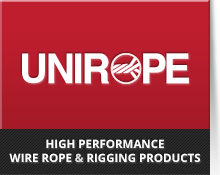WIRELOCK® General Technical Information

-
WIRELOCK® is designed to gel (Change from a liquid to a solid) in approximately 20 minutes at 18°C (65°F). To ensure the kits are not adversely affected by storage they should be kept in a dry place at a temperature of between 10°C and 24°C (50°F and 75°F) and away from any source of direct heat. WIRELOCK®, like all polyester resins, is temperature sensitive. An increase in temperature of 10°C (15°F) shortens the gel time by approximately 50%. A decrease in temperature of 10°C (15°F) lengthens the gel time by approximately 100%.

-
The specific gravity of WIRELOCK® is 1.73 Therefore, 1000cc’s will weigh 1.73 kilos or 3.81 lbs. 250cc’s will weigh 1.73
1.73 x 250 = 0.43 kilos or 0.95 lbs. 1000 -
WIRELOCK® Wire Rope Assemblies are 100% efficient when used with steel wire rope, galvanized wire ropes and stainless steel wire ropes. We do not advise the use of stainless steel wire rope in a salt water marine environment without regular inspection. In the presence of an electrolyte, i.e. sea water, electrolytic degradation of the stainless steel wire rope can occur. This phenomenon, known as crevice corrosion will impair the integrity of the rope in the region near to the neck of the socket. Crevice corrosion also occurs when white metal is used for socketing (Zinc should not be used to socket stainless steel rope). However the onset of crevice corrosion in resin sockets appears to be faster than when white metal is used. Other rope types do not exhibit this behaviour. See illustration.

Typical example of the swelling of stainless steelrope due to crevice corrosion. -
WIRELOCK® is approximately 20% the weight of zinc.
-
The strength of WIRELOCK®, in its cured state, is not adversely affected by cold temperatures.
-
WIRELOCK® must be mixed and poured (see 6.3) within the temperature range of -3°C to 35°C (27°F – 95°F). The kits are not adversely affected by storage at temperatures below -3°C (27°F). It is recommended the WIRELOCK® kit be stored in a cool place.

-
The operating temperature of WIRELOCK® is +115°C to -54°C (+240°F to – 65°F).
-
When cured, WIRELOCK® has a hardness of approximately 40 to 50 Barcol. When the resin has set fully (opaque green or mustard colour) only a slight scratch mark will be seen when a sharp object, such as a screwdriver blade, is scraped over the surface of the resin. On a small socket, it is quite normal to have a very thin tacky layer on the surface of the resin. The scratch test can be carried out through this layer.
-
Cracks which may appear on the top of the cured cone are surface crazing only, and are a result of heat stresses and shrinkage upon a thin layer of unfilled resin covering the tops of the wires. The crazing does not affect the strength of the termination within the socket.
-
Shrinkage of the WIRELOCK® cone may leave a gap between the cone and the socket wall. This is normal, particularly with large sockets and high ambient temperatures. This in no way affects the efficiency of the assembly. Upon loading, the cone will be seated perfectly in the socket. The shrinkage of WIRELOCK® is between 1.5 – 2.0%. In high volume WIRELOCK®, the shrinkage is about 0.5%.
-
Excessive numbers of horizontal rings in the socket may increase the load required to “seat” and wedge the cone within the socket. They should be avoided whenever possible and a proof load applied (not exceeding 60% of MBL) if they must be used. Alternatively they should be filled in with clay, prior to placing the socket on the rope.
-
WIRELOCK® poured sockets should not be used in environments of strong caustic or acid solutions. WIRELOCK® is not affected by oils, or grease or salt water.
-
WIRELOCK® is, by design, a compressive resin. Therefore, when removed from the socket a WIRELOCK® cone, if hit by a hammer, may shatter. In a socket, even under extreme loads or shockloads, the WIRELOCK® cone remains solid and 100% efficient.
-
The shelf life of WIRELOCK® is eighteen (18) months (check label before use) from the date of manufacture.



